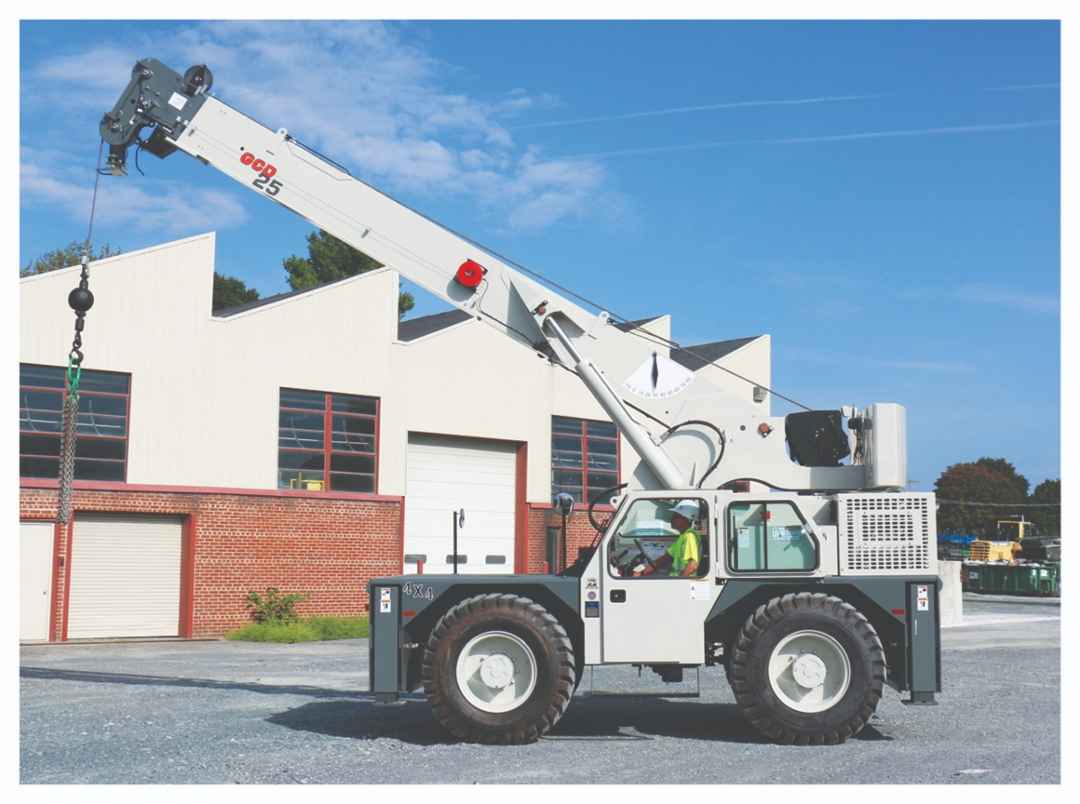Compact Powerhouses
Pick-and-carry and carry-deck cranes combine maneuverability with lifting power
Their capabilities make them indispensable for modern industrial operations. Industrial cranes — especially pick-and-carry and carry-deck models — are essential tools across factories, warehouses, refineries and construction sites. They are not only a common sight on steel fabrication, precast concrete, equipment repair, plant maintenance and timber-frame construction jobsites, their adaptability extends far beyond those typical applications.
Compact yet highly capable, pick-and-carry and carry-deck cranes combine maneuverability with lifting power. In facilities where space and access are restricted, these machines deliver precision without the logistical complexity of larger equipment. They move easily through doorways, navigate overhead obstructions and transport loads capably and safely.
Unlike other cranes that require separate transport equipment, pick-and-carry and carry-deck models can be moved to jobsites and put to work with minimal set up time. On the job, their design — typically featuring a rotating boom, flat deck and four-wheel steering — allows operators to lift, move and place loads in confined spaces with minimal effort.
With the ability to save time and resources, the all-in-one capability of pick-and-carry and carry-deck cranes have increasingly made them a flexible alternative to larger machines. According to Manitowoc’s Mike Heinrich, vice president of sales for boom trucks and industrial cranes, the market has also shifted toward higher capacities in recent years.
“The most popular models were 9-ton machines because they’re great for internal use and can fit through an 80- by 60-inch door,” Heinrich said. “You can also use them outside.
“While they’re still very popular, as newer facilities feature larger doors and access in general has grown easier, demand has increased for higher capacity models and 15-ton machines have now eclipsed the 9-ton units,” Heinrich continued. “Additionally, some users are finding they can even substitute a 25-ton carry-deck for a 30-ton rough-terrain crane because the capacities are similar.”
With their growth in use, industrial crane manufacturers have been integrating advanced technologies. To improve safety, many models now include operator-assist systems, such as Rated Load Indicators, ergonomic controls and load moment sensors. The solutions also simplify training and reduce human error on jobsites.
For enhanced efficiency, the latest pick-and-carry and carry-deck cranes feature telematics for improved machine management. Environmental performance is also an ongoing area of focus that is centered on electric and hybrid power systems. Manufacturers, for example, are addressing battery development with companies exploring modular, swappable battery packs that extend runtime and reduce downtime.
Grove and Shuttlelift
Offered under the Manitowoc umbrella, Grove and Shuttlelift carry-deck cranes share design features and performance capabilities. Each brand has four corresponding models, ranging from 9- to 25-ton lifting capacities. For example, the Grove GCD09 is equivalent to the Shuttlelift SCD09. Each model also has a main boom length of 33.2 feet, a maximum tip height of 48 feet and a 12-foot boom extension.
The other Grove and Shuttlelift models are the 15-ton capacity GCD15 and SCD15 with a 41- to 50-foot main boom length, 15 feet boom extension and a maximum tip height of 69.5 feet.

Offered under the Manitowoc umbrella, Grove and Shuttlelift carry-deck cranes share design features and performance capabilities. Each brand has four corresponding models, ranging from 9- to 25-ton lifting capacities.
 The 20-ton GCD20 and SCD20 have a 54.5-foot main boom, an 86-foot maximum tip height and can accommodate 15- to 25-feet of boom extension. The 25-ton GCD25 and SCD25 have a 95-foot tip height, a 17-foot boom extension and a 71-foot main boom length.
The 20-ton GCD20 and SCD20 have a 54.5-foot main boom, an 86-foot maximum tip height and can accommodate 15- to 25-feet of boom extension. The 25-ton GCD25 and SCD25 have a 95-foot tip height, a 17-foot boom extension and a 71-foot main boom length.
Options on Grove and Shuttlelift models include a pivot boom nose for more lifting flexibility and a searcher hook for lifts in areas with low headroom.
Tadano Valla
Tadano Valla fully electric, battery-powered models include the 19E series with 1,990 pounds of lifting capacity, a tip height of 15 feet and a horizontal outreach of 10 feet with a lifting capacity of 880 pounds at maximum reach.
The company’s 25E series is available in two models, the 25E and 25EL (25 Electric Light). The only difference between the units are the counterweights with the Valla 25EL weighing in at 4,400 pounds while the heavier 25E weighs in at 5,300 pounds. Boasting a 15-foot tip height and 10 feet of horizontal outreach, the Valla 25EL has a maximum capacity of 4,950 pounds while the 25E has a maximum of capacity of 5,500 pounds.
The Valla V40R has a lifting capacity of 8,000 pounds, a 25-foot tip height and 16 feet of maximum outreach. The V90R model has 18,000 pounds of capacity with a crossbar and pick and carry hook and 15,400 pounds of capacity on wheels with a winch, and 32 feet, 2 inches of maximum height with 16 feet, 6 inches of horizontal reach.

The V120R offers 35 feet of lifting capacity, 21 feet of horizontal outreach and a lifting capacity of 24,000 pounds.
The company also offers the Valla Manipulator for handling glass and other non-porous materials with a maximum capacity of 1,320 pounds.
Bailey Cranes
Bailey Cranes offers the BC18 electric carry-deck crane that boasts an 18,000-pound lifting capacity. The zero emissions machine is powered by an 80-volt battery system featuring enclosed AC traction and pump motors. Optional LP hybrid charging extends operational flexibility while maintaining quiet, clean performance.
Broderson Manufacturing
Broderson Manufacturing models include the 2.5-ton IC-20, 4-ton IC-35, 4.5-ton IC-40, 9-ton IC-80 and the 10-ton IC-100. There are also three 30,000-pound capacity IC-200 models, the 36,000-pound capacity IC-250 and the 40,000-pound rated IC-280.

The largest model in the Broderson product line is the IC-400 with 25 tons of lifting capacity. Main boom lengths across the product line range from 15 feet to 75 feet, 5 inches.
JMG Cranes
With models such as the MC 100RE (22,000-pound capacity) and the MC 50000RE (110,000-pound capacity), JMG Cranes carry-deck cranes feature two electric motors and have the capability for up to eight non-stop hours of operation.
Ormig
Ormig offers a range of electric pick-and-carry cranes, including the 5.5 TME, 15IE, 16 TME, 25 TME, 35IE, 40 IE, 55/60IE and the 100IE. Diesel pick-and-carry cranes from the manufacturer include the 16 TM, a 16-ton capacity machine, the 55-ton 55 TM and the 75 TM, a 75-ton capacity model.
Market Growth
Despite economic uncertainty, the industrial crane sector remains resilient.
According to industry analyses by Global Market Insights, the global market for industrial cranes is valued at $12.5 billion (2024) and is projected to have 4.3% Compound Annual Growth Rate through 2030. Much of this demand will be fueled by the infrastructure, energy and manufacturing sectors, which account for roughly 65% of total revenue.
With sales forecasted to increase by 30% by 2028, electric and hybrid industrial crane models are expected to drive the next wave of growth. As operators look to reduce emissions and operating costs, the appeal of electric carry-deck and pick-and-carry cranes will only continue to expand.
From the production floor to the jobsite, today’s industrial cranes reflect a convergence of compact engineering and technological sophistication. Carry-deck and pick-and-carry cranes may lack the towering presence of rough-terrain or crawler cranes, but they excel when precision and agility matter most. As industrial operations evolve to meet the demands of tighter timelines, denser layouts and growing sustainability goals, a new generation of these cranes is poised to meet the challenge.



